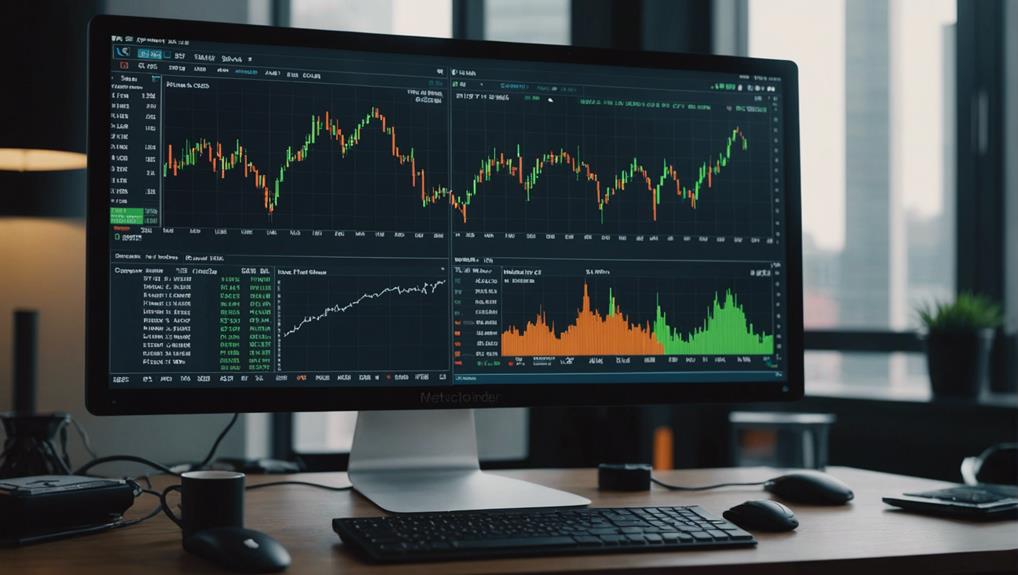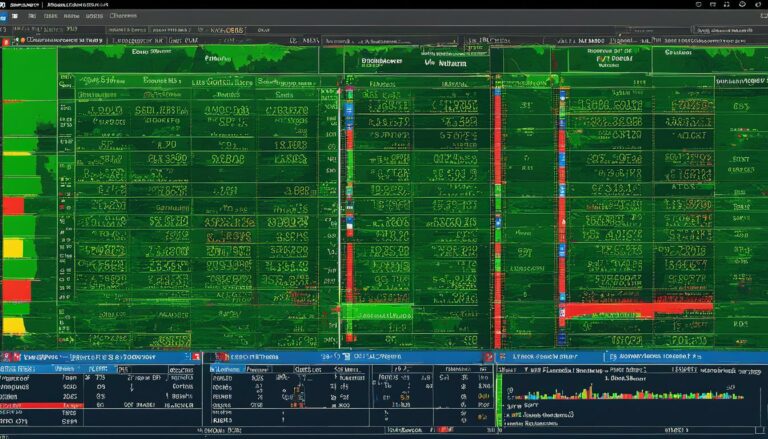When comparing Metatrader 4 and Metatrader 5 for traders, the subtle differences are essential. Metatrader 4 boasts a traditional layout, while Metatrader 5 offers a modern interface.
Regarding analytical tools, Metatrader 4 provides a vast library, but Metatrader 5 excels in indicator compatibility. For order execution speed, Metatrader 5 outshines with faster processing.
Programming on MQL5 in Metatrader 5 enhances data handling. Asset classes are more diverse on Metatrader 5, diversifying portfolios. Mobile trading efficiency is boosted on Metatrader 5. Understanding these distinctions aids in informed decisions for traders in the dynamic platform landscape.
User Interface Variances
In comparing Metatrader 4 and Metatrader 5 for traders, the user interface variances play a significant role in determining which platform best suits individual trading preferences. The design aesthetics and platform layout of both versions differ, impacting the overall user experience and navigation efficiency. Metatrader 4 boasts a more traditional interface with a familiar layout that many traders have grown accustomed to over the years. Its simplistic design and easy-to-navigate menus make it a popular choice among traders who prefer a straightforward trading platform.
On the other hand, Metatrader 5 introduces a more modern and visually appealing interface. The platform layout is structured to provide traders with a more customizable experience, allowing for greater flexibility in arranging tools and features based on individual preferences. While this may enhance the aesthetic appeal of the platform, some users may find the new layout initially challenging to navigate compared to the more intuitive design of Metatrader 4. Ultimately, the choice between the two platforms often comes down to personal preference regarding design aesthetics and navigation efficiency.
Analytical Tools Comparison
Comparing the analytical tools of Metatrader 4 and Metatrader 5 reveals distinct differences in functionality and effectiveness for traders. Metatrader 4, being the older platform, boasts a vast library of custom indicators and expert advisors developed over the years, providing traders with a wide array of tools to analyze the markets. However, Metatrader 5 offers enhanced indicator compatibility, allowing for more advanced technical analysis with a broader selection of indicators that can be utilized.
In terms of backtesting accuracy, Metatrader 5 has an edge over its predecessor. The backtesting functionality in Metatrader 5 is more precise and reliable, providing traders with a better simulation of their trading strategies in historical market conditions. This increased accuracy can be essential for traders looking to fine-tune their strategies before deploying them in live markets. Overall, while Metatrader 4 has a more extensive library of tools, Metatrader 5’s improved indicator compatibility and backtesting accuracy make it a compelling choice for traders seeking advanced analytical capabilities.
Order Execution Speeds

Metatrader 4 and Metatrader 5 show contrasting performance when it comes to order execution speeds, a critical factor for traders in fast-paced markets. When comparing the two platforms, Metatrader 5 generally exhibits faster order processing speed than its predecessor, MT4. This difference in speed can be attributed to the upgraded architecture and enhanced technology of Metatrader 5, which allows for quicker trade executions.
In terms of latency comparison, Metatrader 5 boasts lower latency levels compared to Metatrader 4. Lower latency means that orders are executed more swiftly, reducing the time it takes for traders to enter or exit positions. This advantage can be vital in volatile market conditions where every second counts. Traders looking to capitalize on rapid price movements may prefer Metatrader 5 due to its superior order execution speeds and lower latency, providing them with a competitive edge in executing trades efficiently.
Programming Capabilities Variation
The difference in programming capabilities between Metatrader 4 and Metatrader 5 significantly impacts traders’ ability to customize and automate their trading strategies effectively. Metatrader 4 mainly uses MQL4, while Metatrader 5 utilizes MQL5. The shift from MQL4 to MQL5 brought notable improvements, offering traders enhanced language support and coding efficiency.
MQL5, the programming language for Metatrader 5, supports a more diverse range of data types and has a more extensive standard library compared to MQL4. This expanded language support enables traders to implement more complex trading algorithms and strategies with greater ease.
Moreover, MQL5’s coding efficiency allows for faster execution of trading operations and optimization processes. The improved performance of MQL5 in handling large volumes of data can be vital for traders executing high-frequency trading strategies or working with multiple asset classes simultaneously.
Asset Classes Availability

Asset availability across different asset classes plays an essential role in traders’ decision-making processes when choosing between Metatrader 4 and Metatrader 5 for their trading activities. Metatrader 4, being the older platform, offers a wide range of trading instruments across various asset classes, including forex, commodities, indices, and stocks. However, Metatrader 5 has expanded market coverage and provides access to a more diverse selection of assets compared to its predecessor. Traders using Metatrader 5 can trade not only traditional assets but also additional instruments like cryptocurrencies and futures contracts. This broader market coverage in Metatrader 5 enhances the platform’s appeal to traders looking to diversify their portfolios and explore different markets. The availability of a more extensive range of trading instruments in Metatrader 5 underscores its advancement over Metatrader 4 in catering to the evolving needs of traders seeking exposure to a broader array of financial products.
Mobile Trading Experience
The mobile trading experience comparison between Metatrader 4 and Metatrader 5 centers around the MT4 mobile interface, MT5 chart customization capabilities, and the speed of execution. Traders often weigh the ease of navigation and functionality offered by the MT4 mobile platform against the enhanced charting tools available on MT5 when making their choice. Speed of execution on mobile devices plays an important role in determining which platform suits traders’ needs best.
MT4 Mobile Interface
Comparing mobile interfaces of MT4 and MT5 reveals distinct differences in usability and functionality. Regarding platform compatibility, both MT4 and MT5 offer mobile applications that are compatible with iOS and Android devices, ensuring accessibility to a wide range of users. However, when considering technical indicators, MT5 provides more advanced options compared to MT4 on mobile platforms. The table below summarizes key differences in the mobile interfaces of MT4 and MT5:
| Feature | MT4 Mobile Interface | MT5 Mobile Interface |
|---|---|---|
| Platform Compatibility | iOS, Android | iOS, Android |
| Technical Indicators | Limited selection | Advanced options |
These differences make MT5 a preferred choice for traders who rely heavily on technical analysis while on the go.
MT5 Chart Customization
Mobile traders using MT5 benefit from enhanced chart customization options compared to MT4, allowing for a more tailored trading experience on handheld devices.
- Chart Layout: MT5 offers more flexibility in adjusting chart layouts, such as grid line customization and color schemes, providing traders with a visually pleasing interface.
- Technical Indicators: MT5 supports a wider range of technical indicators, enabling traders to conduct more in-depth technical analysis directly on their mobile devices.
- Drawing Tools: The platform includes an expanded set of drawing tools for trendlines, shapes, and annotations, empowering traders to mark up charts effectively while on the go.
These enhancements in chart customization on MT5 contribute to a more user-friendly and personalized trading environment for mobile users.
Speed of Execution
When evaluating the speed of execution in the mobile trading experience between Metatrader 4 and Metatrader 5, traders may observe significant differences in transaction processing times. A key factor to take into account is the latency comparison between the two platforms, impacting the speed at which trade execution occurs. Metatrader 5 generally boasts lower latency compared to Metatrader 4, potentially providing faster order processing. Additionally, traders should evaluate broker compatibility to guarantee top performance. Slippage analysis is essential in determining the efficiency of trade execution速度, with Metatrader 5 often showing improvements in this aspect compared to its predecessor. By taking into consideration these factors, traders can make informed decisions regarding the speed and efficiency of their mobile trading experience.



